#korean filmmakers
Explore tagged Tumblr posts
Photo


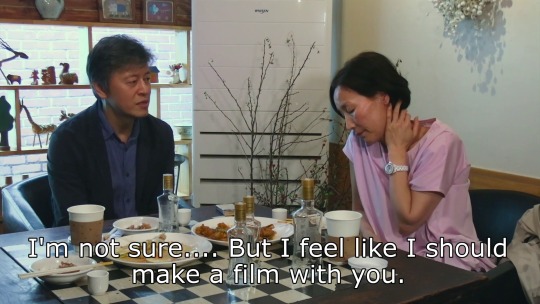
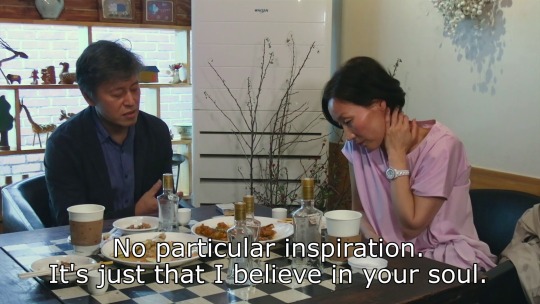
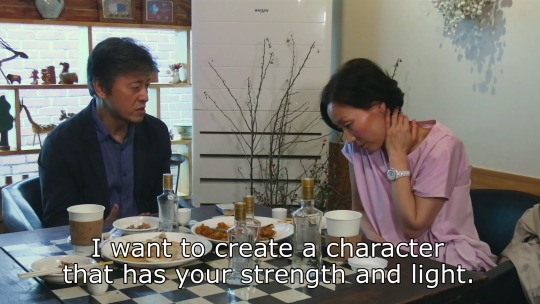
당신 얼굴 앞에서 [In Front of Your Face] (Hong Sang-soo - 2021)
#당신 얼굴 앞에서#In Front of Your Face#South Korea#beauty#Hong Sang-soo#drama film#Hyeyoung Lee#Kwon Hae-hyo#dangsin eolgul ap-eseo#Jo Yoon-hee#Kim Sae-byuk#director#cinematography#Seoul#domestic realism#relationships#actress#passion#rainfall#thunder#lunch#friends#soul#Far east cinema#Korean society#Korean filmmakers#flirting#romantic drama film#drunk#Cinema of South Korea
5 notes
·
View notes
Text
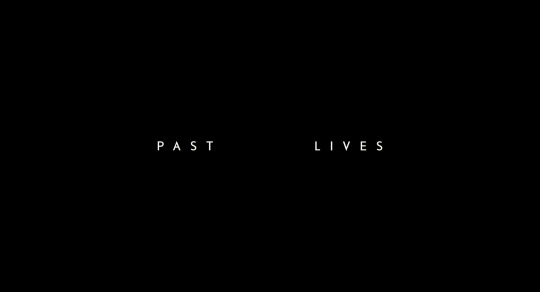

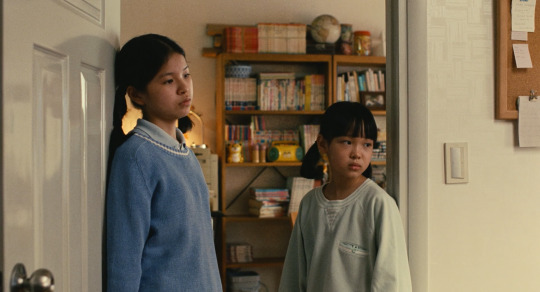

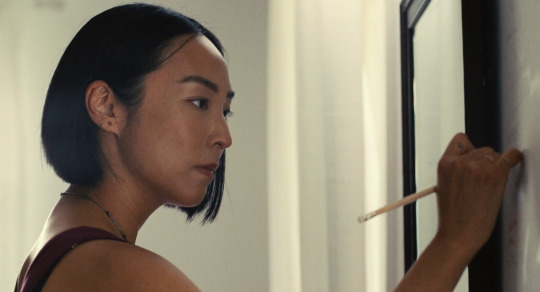
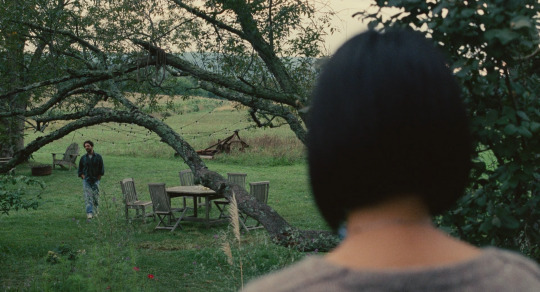

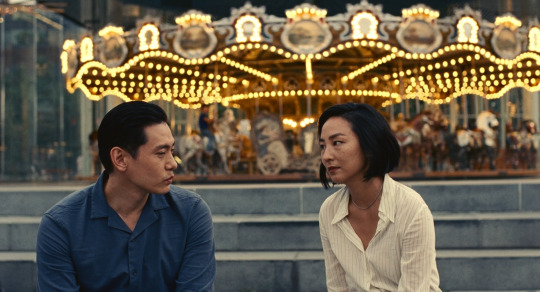
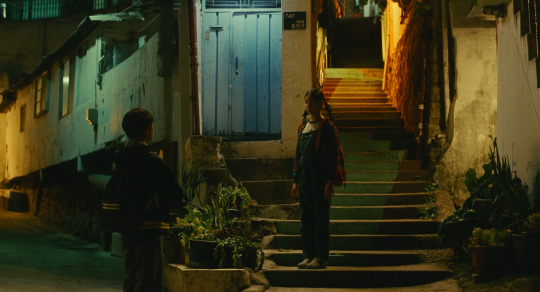

Past Lives (Celine Song, 2023)
#greta lee#teo yoo#past lives#celine song#a24#female filmmakers#female directors#women in film#female screenwriters#female directed films#korean american#korean#asian american#south korea
678 notes
·
View notes
Text
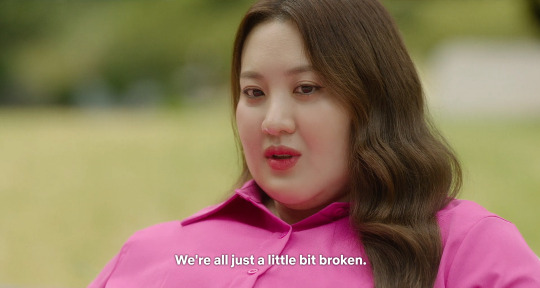
The Atypical Family (2024) dir. Jo Hyun Tak
#netflix#the atypical family#jang ki yong#chun woo hee#kim soo hyun#stills#caps#film#film stills#screencaps#screenshots#filmmaking#cinema#dailyworldcinema#cinemaspam#cinephile#filmedit#cinematography#kdrama#korean
31 notes
·
View notes
Text
Filmmaker Park Inje made the most of his recent trip to the United States to attend the Critics Choice Awards, where his Disney+ K-drama “Moving” was nominated for Best Foreign Language Series.
“After I arrived, I went to the Guitar Center in Hollywood,” the director said in an interview over Zoom. “I was really excited to see all the guitars used by legendary artists, including the guitar that Eddie Van Halen used to use. My wife and I are going to explore L.A. a bit and we are kind of interested in seeing Las Vegas and places like that. And the Grand Canyon. Then we’ll head back home to South Korea.”
Prior to directing the superhero series, Park had helmed season two of the Netflix hit series “Kingdom.” This interview was conducted in Korean and translated into English.
#Park In-je#Park Inje#“Moving”#K-drama#“Kingdom”#director#Filmmaker#Korean#I wrote this#Chicago Tribune
3 notes
·
View notes
Video
youtube
New video - Me and Mickey Mouse does a language challenge enjoy!
#youtube#youtuber#videos#language challenge#speaking languages#geography#mickey mouse#disney#animation#filmmaking#tagalog#japanese#spanish#italian#portuguese#romanian#croatian#german#korean#thai#jamaican#swahili#comedy#skit#philippines#japan#italy#germany#korea#thailand
1 note
·
View note
Text
Melo Movie
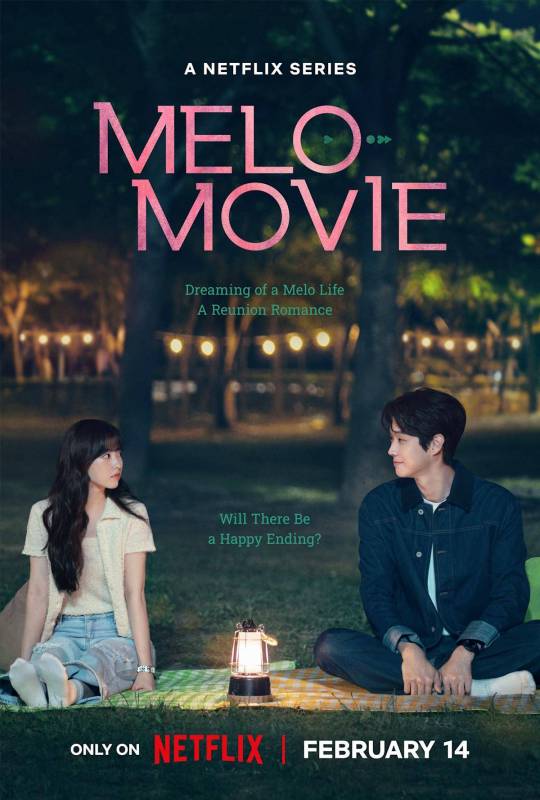
TV Shows/Dramas watched in 2025
Melo Movie (2025, South Korea)
Director: Oh Chung Hwan
Writer: Lee Na Eun
Mini-review:
I loved Our Beloved Summer back in the day, so I was really looking forward to seeing the writer work with such an exciting cast and director. And, somewhat surprisingly, I think Melo Movie struck even more of a chord with me. It's true that Lee Na Eun rehashes a lot of the ideas that made OBS so popular, but she continues to prove herself as an impressively insightful and sensitive writer. In particular, I deeply connected with her approach to grief. The shorter length means that the story can avoid unnecessary dragging, so it never has a chance to get boring. Also, the two couples showcase different but equally interesting dynamics, all of it aided by a superb cast. And, of course, Oh Chung Hwan's works are always visually pleasant and engaging. All in all, this drama knows how to execute its familiar elements to perfection.
P.S. I'm obsessed with the song Taehyun and Huening Kai of TXT made for the soundtrack 💙💙💙
#melo movie#oh chung hwan#lee na eun#choi woo shik#park bo young#lee jun young#jeon so nee#kim jae wook#cha woo min#kim hee jung#ko chang seok#kim young woong#txt#tomorrow x together#kang taehyun#hueningkai#romcom#romantic comedy#romantic drama#filmmaking#kdrama#korean drama#2025 tv shows and dramas
6 notes
·
View notes
Text
https://gofund.me/63a02c4c
I have a menu going for my 5-day film shoot because if I'm going to have a 5 day shoot, I need to feed people.


#please help#support#brown filmmakers#every dollar helps!#film#filmmaking#queer filmmaker#support queer artists#support queer creators#art school#food#asian food#Asian filmmaker#crock pot recipes#Korean food#dessert#breakfast
0 notes
Text
youtube
Una combinación de todas mis pasiones: Dibujo, Animación, Pintura, Fotografía, Cine y Música. Aprendí mucho haciendo este video y creando esta Obra de Arte, se siente bien salir de mi zona de confort de vez en cuando.
Beethoven - Sonata para piano No. 23 en Fa menor, Op. 57 Hara Noda - Blues Bradford Nyght - The Itch Albinoni - Adagio en Sol menor DARIO - The SuperArtwork
#ad#content#samsung#mobile#korea#korean#south korea#cool#editor#reference#colors#edit#nice#music#art#design#film#filmmaker#photo#Youtube
0 notes
Text
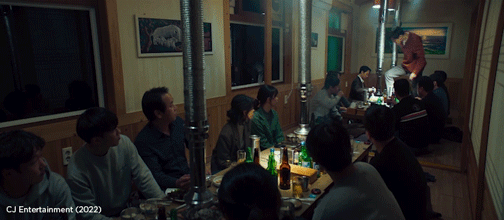


Of all the filmmaking elements, editing is probably the most important when it comes to suspense films. Remember, time is crucial in suspense and editing can manipulate time in significant and interesting ways.
When editing suspense films, your number one mission is to slow things down. The manipulation of time and the delay of events is the definition of suspense. Let’s look at a scene from The Birds, courtesy of Alfred Hitchcock — the master of suspense.
In the film, Decision to Leave follows Hae-joon (Park Hae-il), a married, insomniac detective who is tasked with investigating the death of a man who has plunged from a rocky mountain peak while climbing. When he interrogates the man’s much younger Chinese wife, Seo-rae (Tang Wei), he finds himself as attracted to her as he is suspicious of her. As he digs deeper into the investigation, Hae-joon finds himself lost in a web of deception and desire.
Film editing is important to build the suspense using transition, juxtapositions and the appropriate timing.
0 notes
Text

Wildly Wealthy Koreans (1); inspired by Crazy Rich Asians
Pairing: Jungkook x (f.) Reader
Genre/Tags: photographer/ filmmaker! jungkook, rich girl/ fashion designer! reader, established relationship, angst, fluff, potential smut
Series summary: When you invite your boyfriend, Jungkook, to accompany you to your brother's wedding in your hometown, Daegu, he’s overjoyed, eager to meet your family and experience a side of your life you’ve never shared with him. However, once he uncovers the truth about who you really are, he’s unable to grasp the full extent of your reality. The situation becomes even more complicated when a certain someone makes him feel profoundly unwelcome, leaving him to question not only your world, but also his place in it.
Disclaimer: This series is heavily inspired by the movie Crazy Rich Asians, with the storyline closely following the original film's plot. However, I wanted to reimagine it as a fanfiction, where Jungkook and OC take center stage as the main protagonists. While I’ve kept the core elements and themes from the movie, I’ve added my own touches here and there, such as altering certain character dynamics and incorporating a few original settings. Some scenes are directly inspired by the movie, and I’ve worked to recreate them in a way that it hopefully resonates with the fans of the movie. Hope you enjoy!!
Word Count: 6.6k+
Chapter Warnings: nothing major for now, lmk if i should add anything.
A/N: okay so after much thought, I decided to write this fic because Crazy Rich Asians is, without a doubt, my ultimate comfort movie. I literally rewatch it every chance I get because there's just something about the vibes, the story, and the characters that I can never move on from. That’s exactly why I wanted to create my own little version of it, with Jungkook as the main character. let me know your thoughts and tell me if this is worth continuing. also should i make a taglist for this?
part 1
Jungkook sits in the dimly lit corner of the restaurant, his fingers absently tracing the rim of his water glass. The soft hum of classical music mingles with the low chatter of the people around, but none of it distracts him from the bubbling anticipation inside as he waits for you.
It’s been four months since the two of you had officially started dating, and though you guys had been cautious about defining what you meant to each other, these past months have solidified everything for him. You aren’t just someone he likes... you’re someone who makes his world brighter in ways he never thought possible.
New York has been his home for years now, but it didn’t always feel that way. When he abruptly moved here with his mom during high school, he reluctantly traded the familiar streets of Busan and the ocean breeze he grew up with for the city that never sleeps.
The move was sudden, jarring even, but over time, he adjusted. The city shaped him, sharpening his edges and teaching him resilience. Now, he’s built a life here, chasing his passion for storytelling as a photographer and documentary filmmaker, capturing untold stories that deserve to be heard.
Life was peaceful... steady, even. And then you walked in and turned everything upside down, in a good way.
He met you almost a year ago, purely by chance. He was documenting behind-the-scenes moments at a charity gala, a commission he almost didn’t take, when you appeared, orchestrating the chaos of models, designs, and flashing cameras like the professional powerhouse you are.
You were magnetic, the kind of person who commanded attention without even trying. Jungkook watched from behind his lens, capturing candid moments until one of your colleagues introduced him to you.
“Ah, so you’re the genius behind the lens.” you teased, offering a hand. “I’m Y/N, the one responsible for the clothes you’re immortalizing.”
Your confidence threw him off guard, but what stayed with him was your laugh... so soft and so genuine, the kind that lingers in his mind long after the event ends.
What followed after was a series of serendipitous run-ins—an art exhibit here, a mutual friend’s dinner there. Each meeting peeled back another layer of who you are, until he realized he was utterly captivated.
Now, as he waits for you to arrive tonight, Jungkook can’t help but think of how far the two of you have come. A lot can change in a year, he thinks. His lips tug into a small smile at the thought of your teasing voice, your quick wit, the way you light up every room you enter. You’ve become the best part of his life, and for the first time in years, he feels genuinely happy.
The sound of heels clicking against the polished floor pulls him out of his thoughts. He looks up, and there you are. You wear a soft pink dress that hugs your form perfectly, your hair framing your face in a way that makes his heart skip. When your eyes meet his, you smile instantly, and Jungkook feels his pulse quicken.
“Sorry I’m late.” you say as you reach the table, placing your bag on the chair as you watch him pull out the chair for you. “I got caught up at work.” you say, taking a seat.
“No need to apologize.” he says warmly, going back to his side of the table. “You’re here now and you look... incredible.”
You roll your eyes playfully, though your cheeks betray you with a faint flush. “Says the guy who looks like he just walked out of a GQ spread.” you giggle.
“Only because I knew I’d be sitting across from you.” he shoots back with a grin. You laugh, shaking your head as you push a strand of hair behind your ear. “Flirt.”
The conversation flows as effortlessly as always, a mix of updates about your respective work lives and lighthearted banter. You tell him about the chaos of coordinating last-minute changes for an upcoming fashion week, while he shares stories from his recent project, a documentary highlighting immigrant artists in the city.
But midway through dinner, he notices a shift in your demeanor. Your laughter softens, and you begin fiddling with the edge of your napkin, a subtle sign of nerves he’s come to recognize.
Jungkook leans forward slightly, resting his hand gently over yours. “You okay?” he asks, his tone soft but laced with concern. You glance up at him, hesitating for a moment before nodding. “Yeah, I’m fine. Just... there’s something I wanted to talk to you about.”
His brow furrows slightly, but his touch remains steady, reassuring. “I’m all ears.”
You take a deep breath, your gaze flicking between him and the table as you speak. “So, um... in three weeks, my brother is getting married. The wedding’s in Daegu, my hometown and my whole family's planning.. all these... these events leading up to it, and...” You pause, mustering the courage to meet his eyes. “and I’d really like you to come... with me.”
Jungkook blinks, momentarily caught off guard. You’ve rarely spoken about your family during your time together. All he knows is that you have an older brother whose name is Kim Taehyung, and that your work keeps you far from home. You’ve always been reserved when it comes to personal matters, and he never pushed, understanding that some things take time to share.
“You want me to meet your family?” he asks, his voice careful but touched with wonder.
You nod, your fingers curling slightly under his. “I know it’s a big step, but... you’re important to me, Jungkook. I want you to know them and I want them to know you... and i just.... I just want you to be there.”
His heart swells at your words, a warmth spreading through his chest that he hasn’t felt in years. He squeezes your hand gently, a soft smile curving his lips. “Of course I’ll go.” he says, his voice steady and full of certainty. “Thank you for asking me. This means a lot, Y/N.”
You exhale, relief washing over your features as your lips tug into a smile. “You have no idea how nervous I was to bring it up.”
“Well, you don’t have to be nervous about anything when it comes to me.” he says, his tone teasing but sincere. “Though... should I be nervous about meeting your family? Any tips I need to survive?”
You laugh, the tension melting away as his words reassure you. “Just be yourself. They’ll love you... I hope.”
“They’d be crazy not to.” he grins, his confidence laced with a playful charm.
As the conversation moves forward, Jungkook can’t shake the weight of what you’ve just shared. This isn’t just an invitation... it’s a glimpse into the part of your world you’ve kept hidden. And he knows, without a doubt, that he wants to be part of it.
//
The three weeks seem to blur together for Jungkook, filled with excitement, planning, and the growing anticipation of returning to Korea. Now, he’s standing just outside the bustling airport, his hands shoved deep into the pockets of his jacket, glancing at the crowd for any sign of you. He knows you’ll be here soon with the tickets, and just the thought of seeing you has a smile tugging at his lips.
It’s been years since he last visited Korea, and the idea of going back stirs up a mix of emotions... nostalgia, eagerness, and a tinge of nervousness. But it isn’t just your family he’s excited to meet... he can’t stop thinking about reuniting with Yoongi, an old friend from his university days.
Jungkook remembers how they first met. Yoongi, fresh from Daegu, adapting to the fast pace of New York, with a wit and humor that made their friendship click instantly. They spent countless nights bonding over shared meals and dreams, but after Yoongi finished his studies and returned to Korea, they lost touch. Now, the opportunity to see him again feels like a bonus to this trip.
When Jungkook had mentioned that he'd be visiting Daegu for a short trip to Yoongi during a rare phone call, Yoongi had insisted, “You better visit me for lunch or dinner the second you land, Jeon. I’ll be waiting.” It had been less of an invitation and more of a command and a promise Jungkook fully intends to keep.
His thoughts are interrupted when he spots you approaching with your suitcase. Your face lights up the moment your eyes meet, and Jungkook feels his heart lift as he strides forward to greet you. He pulls you into a hug, planting a soft kiss on your lips, his familiar warmth seeping into you.
“You ready for this?” you ask, your grin contagious. “With you? Always.” he affirms easily, grabbing your suitcase to lighten your load as the two of you head towards security.
After passing through the usual chaos of airport checks, you finally board the plane. Jungkook trails closely behind, his eyes scanning the rows of economy seats, prepared to settle in for the long flight. But you keep walking, breezing past one row after another, heading towards the front of the plane.
“Y/N...” he calls softly, a frown of confusion crossing his features. “I think we passed our seats.” You barely glance back, simply motioning for him to follow with a playful wave of your hand. “Just trust me, Kook.”
Jungkook’s confusion only grows as you step into the business class section. His steps slow as he takes in his surroundings... the stark difference from the cramped seats in economy hits him instantly. Business class looks like another world.
The seats are spacious, arranged in private compartments with high partitions for privacy. The lighting is soft and ambient, with a warm golden glow that feels more like a cozy lounge than an airplane cabin. Flight attendants move quietly through the aisles, offering passengers drinks and handing out fancy pajama sets.
Jungkook’s jaw drops as he watches you casually slide into one of the luxurious seats, making yourself comfortable. He hurries forward, his voice incredulous. “Y/N, this is business class... Our seats aren’t here!”
You look up at him with a calm smile, gesturing to the seat beside yours. “They gave me an upgrade.” you say simply, patting the spot for him to sit. His eyes narrow in confusion as he sets down his bag. “Upgrade? Can we even afford this?” he asks, using his hands to gesture towards the private compartment.
You laugh lightly, already reclining your seat with the touch of a button. “Relax, Kook. My family has some business ties with the airline. It’s just a little perk.” (Nick Young coded girlfriend)
“A little perk?” he repeats, his voice full of disbelief as he finally sits down. He presses a button on the armrest, watching in awe as the seat reclines into a flatbed. “Y/N, this isn’t a perk... this is a dream. Look at this place! It’s like a five-star hotel in the air.”
You grin, watching his childlike amazement as he fiddles with every feature. "I don’t know if I’ll ever be able to go back to economy class now...that feels like a distant nightmare.”
A flight attendant approaches with a tray of pre-departure champagne, offering the glasses with a polite smile. Jungkook accepts one hesitantly, holding it up like it might break. “Champagne? On a plane? This is insane.” he continues.
You can't help but giggle at his cuteness as you casually take a sip from your glass as if it’s the most natural thing in the world.
As the plane prepares for takeoff, Jungkook leans back in his seat, still marveling at the luxurious surroundings. He sneaks another glance at you, the contentment on your face making his heart swell. This trip is already shaping up to be unforgettable, and it hasn’t even truly started yet.
//
Jungkook feels the weight of your pout pressed against his chest as you stand in his arms, his hands gently brushing through your hair in a comforting motion. He can’t help but smile softly, though he feels the tiniest tug at his heart seeing you so disappointed.
He knew this lunch with Yoongi was important, and he knew you understood... at least, logically. But seeing the way you looked at him, that little furrow between your brows, made him feel a little guilty. “It’s just lunch, baby.” he says, his voice soothing, brushing his thumb gently over your cheek.
“I promised him, and he never takes no for an answer.” He chuckles softly, but his smile fades when he feels the reluctance in your grip on him.
You knew he had plans with Yoongi the moment you touched down in Daegu. You had known this from the start, had heard about the lunch plan in passing, but that didn’t make the feeling any easier to shake.
The thought of him going off without you, to catch up with an old friend while you drove home alone, kind of made you sad. You were fully aware of the importance of this lunch, but that didn’t stop the tiny selfish part of you from wishing he’d be with you, just for a little while longer.
“I know...” you murmur, your voice betraying the tiny bit of sulk in your tone, but you try to let it go. You weren’t going to hold him back. "Fine." you finally say, pulling back to meet his gaze.
And the way he looks at you affectionately makes you feel like you’ve won some small victory. “But...” you add with a little smile. “I expect you to be at my place at 7. You know my grandma’s having that traditional tea ceremony thing and I promised her I was bringing someone special home.”
His eyes light up at your words, the thought of joining you for something so important and so personal. “Of course.” he replies without hesitation, his voice earnest. “I wouldn’t dream of missing it.”
You smile softly, knowing he means it. And yet, despite his assurances, you can’t shake the lingering feeling of missing him. Just a little. Before you can dwell on it too much, you hear a voice break through the moment.
“Ms. Kim.”
You turn, blinking a little in surprise as your driver steps forward, his presence bringing a sudden rush of formality to the otherwise intimate moment. “The car is here.” he states matter-of-factly, and you know that this is your cue to part ways.
You sigh softly, reluctantly loosening your hold around Jungkook’s waist, but not without giving him one last lingering look. Your lips curl in a pout, but you try to hide it behind the gentle smile you offer him.
“Okay then…” you start, your voice trailing off as you look at him, uncertainty settling in your chest. “I’ll see you soon?” The question hangs in the air, like a promise and a plea all at once.
Jungkook watches you for a moment, that familiar ache in his chest growing stronger as he sees the hint of vulnerability in your eyes. But then his lips curl upward, soft but sincere. “Of course, baby. I’ll be there. I love you.” His words are steady, and his eyes hold something deeper than just affection... something unwavering.
You nod quickly, feeling a mix of relief and longing. “I love you too.” you whisper back before turning away, following your driver towards the airport's exit.
Jungkook watches you walk away, his heart heavy in his chest, the pang of guilt creeping up again. He promises himself to make it up to you later. Now, he just needed to get through lunch with Yoongi.
But as soon as the sound of your footsteps fades and you disappear from his sight, his phone buzzes in his pocket. The familiar name on the screen catches his attention, and he answers without a second thought. “Hey, Mom.”
Her voice crackles through the line, warm but concerned. “Hello Jungkook-ah, I just wanted to check in. You landed safely?” she asks.
Jungkook listens to his mom’s voice on the other end of the line, the familiar warmth making him smile despite the anxiousness he feels about what’s ahead. He’s about to step into a world that’s so different from New York, where he’s spent most of his adult life. But now, back in Korea, things feel unfamiliar in a way that both excites and intimidates him.
“Yes, Ma... I landed a while ago.” he answers, feeling a small wave of relief hearing her voice. “That’s good, honey... How’s Y/N?” she asks with that gentle concern she always has for the people he cares about.
“She’s good. She just left though, and I’m waiting for Yoongi to come pick me up.” he replies, smiling softly as he instantly thinks of you. “How does it feel to be back in Korea?” he hears his mom question, her tone soft but curious.
He smiles, leaning against the nearest pillar with his luggage beside him as he waits for Yoongi. “So far, so good, but I’m still at the airport, so I can’t say much.” he jokes. His mom lets out a quiet laugh, the sound comforting.
Then, as if suddenly remembering something, she switches to a more serious tone. “Remember what I told you, Kook... Stay put there. You know how it is in Korea... with the elders and the... the people. It’s very different from here, so please take care with what you say and how you say it.”
It’s a reminder he’s heard before, but hearing it again feels heavier now that he’s here, about to meet your family and step into a culture that’s rooted in tradition and respect, something that’s been passed down for generations.
Jungkook’s smile falters for a moment as he nods, even though she can’t see him. He knows exactly what she means. He’s always been more carefree, more western in his ways of expressing himself, and in Korea, especially when it comes to elders, there’s a deep respect for hierarchy and custom that’s different from what he’s generally used to.
“I know, Ma. I’ll keep everything in mind.” he assures her, his voice more serious now. “You’re not a kid anymore, Kook, but just... be mindful, okay? Don’t let them misunderstand your intentions. I just want you to be careful.” Her voice softens with motherly concern, and Jungkook feels his heart warm.
“I will. I promise.” he replies, knowing that this trip, meeting your family... it’s more important than ever to prove to them that he’s not just another guy in the city.... he’s not just your boyfriend. He wants to show them how serious he is about you and the future you guys could have together.
He glances around at the busy terminal, the buzz of passengers and the distant announcements. It all feels so different from New York. So... foreign. But he’ll make it through. He’s used to adapting. And this, he tells himself, is just the beginning.
“Alright, Kook... you take care, yeah?” she says. Jungkook hums. "I will. Bye, Ma." he replies back and soon, the call ends.
Just as Jungkook tucks his phone back into his pocket, he hears a deafening roar that cuts through the murmur of the airport. The unmistakable sound of an engine revving... loud, aggressive, and powerful, draws his attention immediately.
His head snaps to the right, eyes scanning the street. His gaze locks onto a sleek purple Lamborghini, its engine purring with a force that vibrates the ground beneath him as it races towards him.
Jungkook’s brows furrow, an instinctive suspicion flickering across his face as the car approaches. He’s not sure why, but something feels… off, or rather, intriguing. The car comes to an abrupt halt right in front of him, the tires squealing as they grip the asphalt. Jungkook freezes, blinking in disbelief.
The tinted window slowly rolls down, and for a moment, everything seems to move in slow motion. When the driver’s face comes into view, Jungkook’s heart skips a beat. “Yoongi?!” he exclaims, his voice tinged with utter shock and disbelief.
Yoongi grins, that familiar mischievous glint in his eyes. “Ain’t no way...” Jungkook mutters under his breath, still processing the surreal sight of Yoongi sitting behind the wheel of a car that looks like it belongs to someone straight out of a high-stakes action movie. Yoongi chuckles, clearly amused by Jungkook’s reaction.
“What’s good, my man? Meet my baby.” Yoongi says with a sly smirk, his fingers casually tracing the contours of the steering wheel like this car was just an everyday ride for him.
Jungkook’s mouth hangs open in awe. He can’t remember the last time he was this speechless. The purple Lamborghini gleams under the streetlights, its polished surface reflecting the neon glow of the airport. Jungkook’s eyes follow every curve, every sharp angle, as if seeing it in person is somehow more unreal than he could have ever imagined.
Yoongi, clearly unfazed by the wide-eyed look Jungkook is giving him, steps out of the car with an effortless swagger. He’s dressed in an oversized, silk button-up shirt that drapes over his frame in a relaxed way.
The half-sleeves of the shirt billow out just above his elbows, adding a laid-back yet refined touch to his look. Paired with the shirt are matching shorts that reach just below his knees, the material soft and flowy, almost weightless.
Around his neck, a thick silver chain glints in the sunlight, its boldness standing out against the simplicity of his outfit, giving him an air of casual but undeniable wealth.
Without a word, he grabs Jungkook’s luggage from the ground and begins loading it into the trunk of his car.
Jungkook snaps out of his daze and watches him, still trying to wrap his head around the situation. “Get in, dude." Yoongi laughs with a nudge to Jungkook’s shoulder, his tone light, almost playful, as he walks back around to the driver’s side.
Jungkook slides into the plush passenger seat, still feeling like he’s stepped into another world. The interior of the Lamborghini is unlike anything he’s ever experienced. As his eyes roam around, Jungkook can’t help but feel like he’s in a dream.
Every inch of the car screams excess, sophistication, and unspoken wealth. The steering wheel is trimmed in carbon fiber, the gearshift feels solid in Yoongi’s hand, and everything seems perfectly engineered, like it was crafted for the few who could afford such a ride.
Yoongi starts the engine with a smooth hum, and Jungkook jerks his head towards him, still shocked. "You never told me you had a Lamborghini." he says, his voice betraying his disbelief.
Yoongi just laughs, his eyes glancing briefly at Jungkook before focusing back on the road. "Well, that's because I didn’t have this back in university." he shrugs nonchalantly, a casual smirk playing on his lips. The car pulls smoothly out of the airport, its engine growling like a beast waking up.
Jungkook stares at him, still processing everything. "But wow, dude? You hit the lottery or something? This car is insane." he breathes out. Yoongi chuckles again but doesn’t answer, as if the question doesn’t deserve a response.
The city of Daegu blurs by outside the tinted windows, the sun reflecting off the glass as they drive deeper into the heart of the city. Jungkook can feel the rhythm of the drive, the perfect balance between speed and luxury, as the Lamborghini effortlessly weaves through traffic, its engine purring in a low, contented hum.
The sound of the tires on the road and the occasional rumble of the car’s exhaust fill the silence between them as they talk. Their conversation drifts to more casual topics... catching up on life after university, their mutual friends, and everything in between. Jungkook listens intently, but something about the ride and everything else, still has him on edge.
Then, suddenly, the city streets begin to change. The hustle and bustle of downtown Daegu fades away, replaced by quiet, tree-lined roads and grand, gated estates. Jungkook furrows his brows in confusion. The mansions are larger than anything he’s ever seen.
Multi-story buildings with sprawling lawns, perfectly manicured gardens, and tall gates that exude old money. The kind of money that felt untouchable, like a world he’d never thought he’d be a part of.
Yoongi slows the car as they approach a massive set of gates, gleaming with metal and ornate designs. They pause for a moment, and Jungkook watches as the gates swing open effortlessly, granting them access to enter.
Jungkook’s eyes widen even more as they drive in, the long, curved driveway leading them deeper into the estate. The mansion that comes into view is nothing short of breathtaking. It’s grand and set against the backdrop of lush trees, with a modern yet classic architectural style.
The house gleams under the afternoon sunlight, its windows large and open, letting the soft glow of interior lights spill out into the day. As they pass by, Jungkook can’t help but notice the impressive collection of cars parked near the house, each one more expensive than the last.
There’s a black Rolls-Royce Phantom, a gleaming Ferrari 488, a silver Porsche 911 Turbo, and a sleek Aston Martin DB11, all parked in perfect alignment, as if they belong to the same elite circle. The cars shine brightly in the afternoon sun, their polished surfaces reflecting the elegance of the estate.
Jungkook’s mouth hangs open, his mind racing to catch up with the reality unfolding around him. He’s never seen anything like this in his life. "What is this… What is this place?" he breathes out, his voice almost reverent, like he’s stumbled into a world that doesn’t seem real.
Yoongi’s smirk is still there, a knowing glint in his eyes as he pulls the car to a stop, right in front of the grand entrance of the beautiful mansion. He looks over at Jungkook, his tone casual but with a hint of pride. "Welcome to my crib, Kook." he says.
Jungkook's mouth open, words just stuck in the middle of his throat. His mind is still processing everything, the scene outside seeming like a surreal dream. This is all too much to take in.
Yoongi was RICH rich and he didn't have a single clue about it. As they step out of the car, Jungkook notices a man approaching swiftly towards them and by the looks of his attire, it's clear that he's a guard.
Without missing a beat, Yoongi tosses his car keys at him, and the man catches them with practiced ease. "He'll grab your luggage in a bit." Yoongi says casually, already heading towards the mansion's entrance. Jungkook, still processing whatever the hell this is, follows him like a lost child, unable to do anything but take in the overwhelming sight that surrounds him.
The moment they step inside the house, Jungkook's eyes widen, but before he can even begin to appreciate the stunningly opulent interiors like marble floors or the high ceilings or the glistening chandeliers, a shrill voice cuts through the air. "Yoon, you're hereeee!"
Jungkook’s brow furrows as he watches a woman, probably in her 50s, stand right in front of them. She’s dressed in a chic, over-the-top outfit... a silk floral blouse with exaggerated puffed sleeves, tailored trousers, and a lavish pearl necklace that gleams with the faintest hint of arrogance.
Her perfectly styled hair is in a tight updo, and in her arms, she cradles a fluffy kitten, which she’s stroking affectionately, completely oblivious to Jungkook's stunned expression.
Yoongi barely reacts, his face giving away nothing as he responds, "Yes, mom." with a tone that suggests this is nothing out of the ordinary. Without hesitation, he gestures towards Jungkook, who’s still very much amused. “This is Jungkook, a friend from New York.” he introduces calmly.
She steps closer to Jungkook, her eyes widening as she takes in his appearance. "Such a handsome face." she says with a bright smile, fluttering her lashes dramatically. Jungkook feels his ears turn red, but tries to mask it with a polite smile.
"Come, come, why are you still standing by the door?" she continues in a sing-song voice, already turning towards the grand dining hall. "Lunch is just about to be served."
Without waiting for a response, she leads them through the sprawling corridor, her heels clicking against the polished marble floor. Jungkook follows, still processing the luxury surrounding him.
As they enter the enormous dining room, the sheer size of the table takes his breath away. It looks like something straight out of a royal palace, with intricately carved wood and sparkling silverware laid out meticulously. Seated around the table are five people, two men, a woman, and two little girls. The air feels heavy with formality and expectation.
Yoongi, noticing Jungkook's distracted gaze, gestures towards each person with casual confidence. "That's my dad." he says, pointing to the middle-aged man sitting at the center of the table who gives Jungkook a bright smile, as he nods acknowledging his presence.
"That's my brother, Geumjae." Yoongi continues, nodding towards the younger man seated to the left. Geumjae has the same sharp features as Yoongi, and he cheerfully waves at Jungkook. "Yooo." he says.
Next, Yoongi points at a woman sitting beside him. "That's his wife, Chaeri." he adds, the warmth in his voice making it clear they have a close bond. "And those are his daughters, Minji and Yuna." he finishes, gesturing to the two little girls sitting next to each other as they giggle shyly to themselves.
Jungkook nods politely at everyone, his nerves creeping in as he takes in the situation. Yoongi's family seems very welcoming, but he's still extremely nervous. He’s not used to this kind of environment, and it shows, but he quickly remembers his manners. He straightens up and gives a right-angled bow, a gesture of respect that his mother taught him for situations like this.
"Hello, I’m Jungkook." he says, his voice steady but laced with a slight hint of uncertainty. He smiles warmly at them, hoping his attempt at a formal greeting isn’t too awkward.
Jungkook feels a shift in the atmosphere as Yoongi's father lets out a hearty laugh. "Yahh, no need to be so formal." he chuckles, waving a hand dismissively.
"Come, take a seat before the food gets cold." His voice is warm and inviting, making Jungkook relax a little. Geumjae, his brother, nods in agreement. Jungkook looks at Yoongi, unsure, but Yoongi simply gives him a small shrug and gestures for him to sit.
They both take their seats, followed by Yoongi’s mother, who settles herself gracefully at the table. Jungkook glances around, noticing the opulence of the setting... the gleaming china plates, the glistening silver cutlery, the rich aroma of the food filling the air. He feels a bit out of place but tries to steady himself, taking in the high-end cuisine laid out before him.
Once everyone is served, Jungkook’s mind races for a moment as he looks at the elaborate dishes in front of him. He’s unsure where to begin, not used to this kind of extravagant meal. It’s all so foreign to him, but before he can pick up his chopsticks, Yoongi’s father breaks the silence.
"So, what brings you here, Jungkook?" he asks, his deep voice cutting through the air with curiosity. Jungkook swallows his nerves before answering.
"Oh, I’m... I’m here with my girlfriend for her brother’s wedding." he replies politely, hoping his words don’t come out too awkwardly.
"Wedding, huh?" Yoongi chimes in from beside him, raising an eyebrow. Jungkook simply nods in acknowledgment, hoping the conversation will shift.
"So this is your girlfriend’s hometown?" Geumjae asks, his voice calm but probing.
"Yes." Jungkook confirms with a small smile, relieved to stick with the easy part of the conversation. "But damn, dude, when did you get a girlfriend? The last time I remembered, you were afraid to even approach girls in university." Yoongi teases, a smirk on his lips.
Jungkook freezes for a moment, feeling a flush of discomfort rise in his chest. The comment feels casual, but the atmosphere around him is so formal that it catches him off guard. He glances around the table, noticing that everyone is relaxed and waiting for him to answer, as if this were a normal part of their dinner conversation. He takes a breath and tries to steady himself.
"Well... I wasn’t really afraid to approach them." he says, carefully choosing his words. "I just had other things to focus on." He offers a half smile, hoping to deflect the attention.
Yoongi chuckles, clearly amused, but doesn’t push any further. "What did you say her name was again?" he asks, his tone light.
"Oh... it’s Y/n." Jungkook replies, a smile creeping onto his face as he thinks about you. Just saying your name makes him feel warm inside, and he can’t help but let a soft grin escape.
"Y/n?" Yoongi’s mother repeats, her brows furrowing slightly, as though the name is familiar but somehow surprising. Jungkook tilts his head, not fully understanding the change in her tone.
He nods, confirming with a small smile. "Yes, Kim Y/n. That’s her name."
The sudden shift in the room is palpable. Yoongi’s mother’s eyes widen, and her voice grows louder, almost demanding. "You mean... Kim Y/n?" she repeats, her tone now sharp, causing everyone at the table to freeze. The clinking of silverware stops as if time itself has paused.
Jungkook blinks in confusion. He can feel the weight of their collective gaze on him, a tension that wasn’t there before. "Yes, Kim Y/n. That’s her name." he says, his voice firmer this time, trying to keep his composure. He doesn’t understand why your name is causing such a stir, but he can sense something is off.
"Dude... the Y/n you’re dating is... Kim Y/n?" Yoongi’s voice is incredulous, his eyebrows raised in surprise. He leans back in his chair, almost scoffing in disbelief.
Jungkook’s confusion deepens. He looks at Yoongi, eyebrows furrowed. "Uh... yeah? You know her or something?" he asks, still trying to piece together the odd shift in the conversation.
Geumjae chuckles, clearly intrigued. "Who doesn't?" he replies. Jungkook furrows his brows, still lost. "What is that supposed to mean?" he asks, his voice laced with perplexity.
Before anyone can respond, Yoongi’s mother’s face lights up with a sudden realization. "Wait, wait, wait, so the wedding you're here for... it's... it's Taehyung's, isn’t it? It’s Kim Taehyung’s wedding!" She beams, her expression a mix of surprise and excitement, as if the revelation is the most obvious thing in the world.
Jungkook’s mind races. He’s still trying to connect the dots, but the sheer shock on Yoongi’s mother’s face throws him off balance and he wonders how she knows that information. "How... How do you know that?" he asks, still trying to process everything.
Before anyone can answer, Yoongi shifts in his seat, leaning slightly towards Jungkook, his eyes wide with disbelief. "Dude... do you have any idea.... who your girlfriend is?" Yoongi asks, the question hanging in the air like a bombshell.
Jungkook’s mouth opens and closes, not understanding the gravity of the situation. His mind struggles to keep up, but he can't seem to make sense of the turn this conversation has taken. "What?" he asks, still confused. "Why... why are you asking me that?"
Yoongi leans back in his chair, his eyes narrowing as if he’s just realized something monumental. "Dude... do you know who 'The Kims' are?? You're dating someone from 'The Kims'. That is literally insane." he states, his voice filled with disbelief.
He looks at Jungkook, half-amused, half-shocked, but when he still notices the utter confusion on his friend's face, his expression softens slightly. Yoongi leans in and places both hands on Jungkook's shoulders, trying to help him process the information.
"Dude, 'The Kims' are one of the most influential families in all of Daegu. Hell, in all of Korea." Yoongi’s voice is filled with a mixture of awe as he continues.
"They own so many companies, it’s insane. From massive real estate ventures, luxury hotels, tech firms, and even a few major pharmaceutical companies, they’re basically untouchable. Every major industry you can think of, 'The Kims' have their fingers in it." He leans back again, his hands still on Jungkook's shoulders, clearly enjoying his friend's stunned reaction.
"And Y/n? She’s a part of that family. I don’t even think you understand how big of a deal that is."
Jungkook’s mind is spinning. He sits there, his thoughts racing, but the words don't seem to connect. All he can do is stare at Yoongi, trying to make sense of everything that’s being said.
His head is still reeling from the idea that the woman he’s been seeing... someone he’s grown to care for so deeply... belongs to such a powerful family. He had never imagined that you, with your down-to-earth nature, would be connected to such wealth and influence.
Yoongi, noticing Jungkook’s silence, smirks before continuing, clearly reveling in the shock he’s causing. "If you were shocked just looking at the estate I live in, wait until you see the kind of place Y/n lives in."
His voice lowers slightly, his tone growing more serious, almost as if he’s sharing a secret. "Her family’s mansion? It’s like something out of a movie. It’s not like any place you’ve ever seen before. We're talking private security, a sprawling garden, a real private estate. It's on a whole other level."
Jungkook feels his stomach tighten as he tries to digest what Yoongi’s saying. He can’t even fathom how he didn’t know this before, how he had no clue that something about your life was so different from anything he had known.
The thought of you being part of this world, a world so far removed from his own, leaves him just sitting there, not knowing what to do with this newfound information.
part 2 ->
series masterlist
my masterlist <3
#jungkook fic#jungkook#jungkook fanfic#jungkook x reader#jungkook fluff#jungkook angst#jungkook smut#jeon jungkook#bts#bts jungkook#bts fic#enemies to lovers#jungkook fanfiction#crazy rich asians
807 notes
·
View notes
Text
4 Minutes and the Cinematography of Nipples
I said before that I thought 4 Minutes was pretty instantaneously the best looking BL on the market for 2024 after one episode. Which, not gonna lie, is a pretty big fucking claim. There’s been a lot of BL that’s come out that’s looked good, and I do think there’s been a steady improvement overall in the market in the last few years. Personally I think Japanese and Korean BL have a stronger production quality over a majority of Thai BL but like, if that’s a hot take I guess I prefer my food spicy.
The point being~ if I’m gonna make such a hyperbolic statement, well I better back it up right?
So I’m gonna break down a few scenes from the first episode, what I liked about them, why they worked for me, and why on a technical level I think 4 Minutes has just got it going on.
For better readability you can also check out this essay here.
Sidenote: my google docs kept trying to autocorrect “Bible” to “the Bible” and idk how to teach google I mean the hot Thai actor and not the book of Jesus.
To start, I’m going to break down this scene featuring Great and his nepo baby cat:
I thought starting with this scene would be good because it’s such a low-key scene and honestly making these simplistic scenes visually interesting is very difficult! But if you have the basics down, the foundations of cinematography and film making, these simpler scenes can be really memorable.
Like yeah we’re all gonna remember this scene because shirtless Bible and oh my god Akira!? - I have only recently learned who Akira is; why is this cat getting a bigger bag than me? - but beyond that, what makes it cool to watch? What makes it interesting? What information does it showcase to the audience?
One thing I added to the video was a grid for the rule of thirds.
Rule of thirds is a shot composition technique applied to both film and photography. It’s the grid you see if you film a homevideo and helps a Director and Cinematographer figure out where to place the subject or subjects of the shot. The idea is the gridlines show you where you “should” place the subject(s) of said shot.
Like everything, the rule of thirds is a guideline in filmmaking, not a hard and fast unbreakable rule. Filmmakers like Wes Anderson like to play more with central composition shots, rather than ROT.
Anyway on to the opening shot, right after our credits and we’re moving into the shot.
To start, the first thing I notice is the scene’s color grading. Color grading in film is the manipulation of raw film footage to create specific color tones throughout a project. Sometimes this grading is more pointed and obvious, think The Matrix, while in other films it’s not as obvious but still very prominent, think Killers of the Flower Moon.
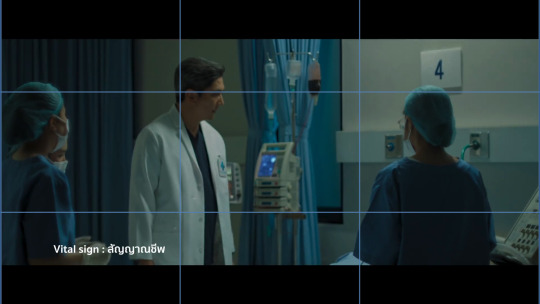
It’s not that the before credits scene looks entirely, jarringly different from the opening scene, but the hospital scene is surrounded by whites and blue tones, it’s darker, and only a single source of light exists. It gives the entire scene a much more frantic, uneasy aesthetic but it’s not so far off from the darker muted tones of the next scene that it feels jarring or out of place.
The second big thing I noticed in the episode is the use of aspect ratio. I’m not 100% sure what aspect ratio the production used exactly, but the use of widescreen as opposed to full screen in my opinion, gives the episode a more cinematic feel to it in comparison to other Thai BLs.
Example, if you look at Century of Love (2024) it appears to be filmed in the standard full screen - which I believe is 16:9? - while 4 Minutes is widescreen (thus the black bars at the top and bottom). Widescreen can give a show a more “movie like” quality to it which is part of the vibes I get from 4 Minutes.

(source)
Onto Great’s actual introduction scene.
We’re not starting the shot with static movement, but with a camera panning right. I’ve talked about camera panning and such in BL before and it’s something I’ve found doesn’t happen as often as it should. Which is a shame! It’s such a simple technique but it adds so much.
Imagine if we entered the frame with a static center shot, and then a cut to Great sleeping and turning off his alarm clock, and then another cut to above the bed. Think about how much more boring that could be visually.
Instead, we enter the scene with movement, panning over and creating some interesting visual framing.
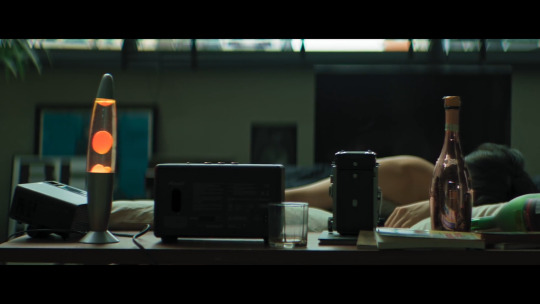
So here’s our opening shot, do you notice anything interesting? To start, what I like about this shot other than the panning movement in, is that we don’t see Great’s face yet. In fact we don’t see his face in full until about 30 seconds into the scene. This builds anticipation, yeah we all know what Bible looks like, but for the audience who doesn’t this helps build anticipation.
Who is this character? What does he look like? What’s his deal?
It also engages the audience more, if you notice part of the composition of the shot has Great in the mid-ground slightly blurred out, while the foreground emphasizes the things on his desk. He’s distant from us, the audience, sleeping off his hangover not yet ready to “join” the world yet.
Here’s another two more things I like about this shot:

Lines.
Using lines and shapes can make a scene more visually interesting and invoke different feelings to the viewer. In this shot, I get a sense of symmetry, the camera panning right, lightly drags across the screen alongside the lines below and above Great, almost creating a frame within a frame effect. As if Great is boxed into a clock in and of itself.
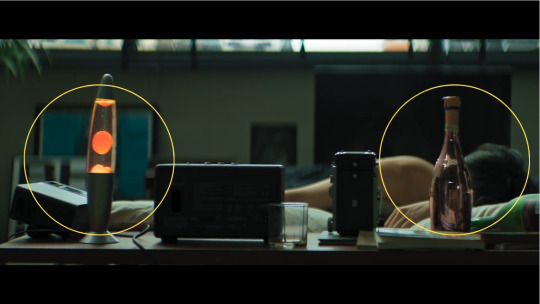
You can also see the use of balance in the scene as well, connecting back to that visual theme of symmetry as well as blocking our view of Great’s face. The lava lamb and champagne bottle are almost the same height, which helps create balance in the shot. The champagne bottle informs us Great has been drinking or does drink since it’s positioned so close to his bed, whilst also continuing to hide his face away from the viewer.
I also like that the lava lamp is a bright spot of color. The tone of the scene is mostly muted greens, and gray, but the bright orange lava lamp and even the pink champagne bottle draw our attention but don’t overwhelm us either. It provides the scene with some warmth but doesn’t offset the overall tone of the color grading.
And then, the last bit of this shot:
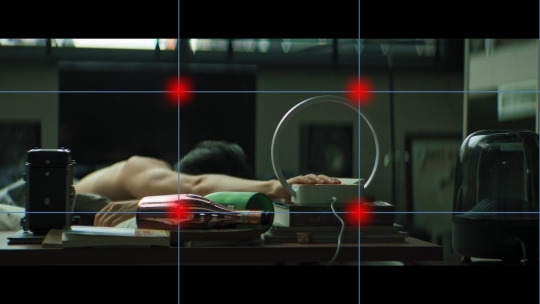
We have Great knocking over the champagne bottom, and turning off his alarm clock. Notice that the alarm clock and the champagne bottle hit those ROT dots almost exactly. There’s also the use of lines by the length of Great’s arm - I just forgot to add a line I’m a failure, a fake, fml - we see him knock over the bottle, and then we follow the line of his arm directly to the alarm clock which is also a shape, a circle.
I like that they used a clock with a specific notable shape, since by the end of this scene the clock is relevant to the story as a whole. Using a shape makes the clock more visually noticeable and memorable to the audience.
So in the next cut we’re above Great - just like Great’s gonna be above Tyme, fuckin hell I’m corny - in a medium-full shot and there’s a couple things I really like here.
I really like the use of lines here with the bed going in one direction but Great’s body going another. It’s disconcerting, and off kilter a bit.
The use of patterns plus the opposing symmetry, whereas in the previous shot the lava lamp and champagne bottle were providing balance, here one side of the bed is patterned, while the other isn’t. This creates a sense of imbalance and makes the shot more visually interesting.
This medium-full shot at a high angle makes Great smaller, and continues to showcase his dishevelment, keeping him distant from the world itself. Also notice the lack of color here as well.
What could this say about Great as a character? Or his story?

So this next cut is the one that actually inspired me to write this essay to begin with and know what I’ma eat some crow here. I originally said it was a great ROT shot but I was wrooooooong. It’s definitely a center composition shot.
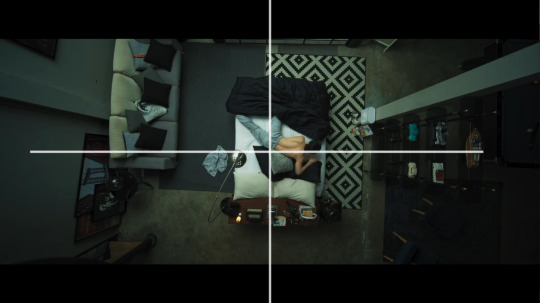
Notice as well, the bed itself is its own shape - rectangle - center in the frame, and yet the shot almost looks unbalanced again because of that singular patterned rug. It’s the only pattern in the entire shot, not even Great’s pillows have noticeable patterns on them.
The above view camera angle in a full shot creates almost an omnipresent feel, as if the audience - or something else? - were looking down upon Great. Whose face we still haven’t seen! It makes him smaller, less powerful, and almost vulnerable. Shots like this are often used in horror films like James Wan’s Malignant (2021) where the horror spector will be looking down above the would-be victim.
Another thing I like about this scene though is we have Great moving. It would be simpler and easier to have his phone just by his alarm clock, or under his pillow, but think about how much more visually interesting it is that he has to move down the bed and reach for his phone. It creates action in an actionless low stakes scene.
And now, 30 whole seconds in and we’ve finally seen Great’s face!
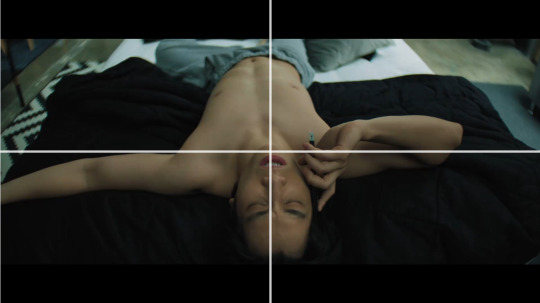
Fun fact, with the ROT grid the gridlines fall right across Bible’s nipples. That’s not a film analysis, just something I noticed entirely intentionally. Thanks Madam Director Ning Bhanbhassa Dhubthien.
The actual shot is in center composition again, as Great rolls over and reveals his face the camera begins to zoom in.
This creates movement in the scene instead of leaving the camera to statically observe it’s now, finally, inviting the audience to meet Great. Pulling us in towards him whereas before we were kept at a distance. Great’s awake and, well as ready to meet the world as somebody with a raging hangover can be.
I also like how Bible is moving constantly in this scene; he rubs his eyes and nose, he twitches his fingers, titles his head back and forth, etc it’s nothing revolutionary but it’s appreciated.
When the scene cuts, we get this shot:

I didn’t put the red dot on his nipple, it just landed there. This is all Madam Director Ning chepie.
But you can see how Great’s body is landing on all those gridlines pretty solidly. Also in the background we see his alarm clock again, a bright blurred circle in the distance. I also like the angle of this shot, as it creates depth in the frame, with Great’s head being in the foreground his lower body in the mid-ground and the background blurred out.
What follows is Akira appearing in frame. Which was really difficult to capture so I don’t have a screenshot. But what I really like is Akira entering the frame out of focus. They could have just cut to Akira, but instead they opted for Akira to enter the frame which is more interesting.
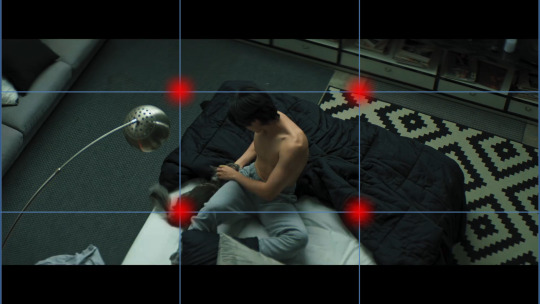
When we do cut, Akira is firmly on one of those dots so we don’t miss them in the frame. I think it’s also interesting that we’ve pulled out again, into a mid-full shot, hanging above Great, and we see that clear symmetry line again between the patterned rug and the regular carpet.
I also really love that when we got to Great sweet-talking Akira and feeding them we’re not just doing a cut, we’re panning downwards which continues to add movement to the scene. And we get that moneyed sponsor shot!

Durex can’t pay for everything okay?
So in the final bit of this scene we get focus on Great, who’s in focus, before he gets up and leaves the frame where the camera then focuses on the clock behind him.
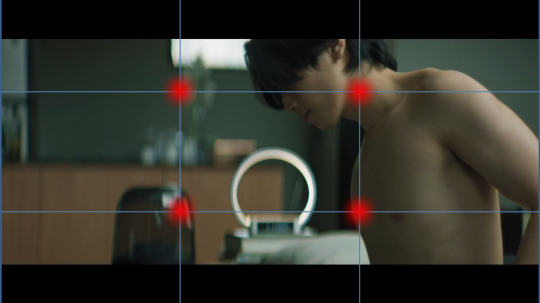
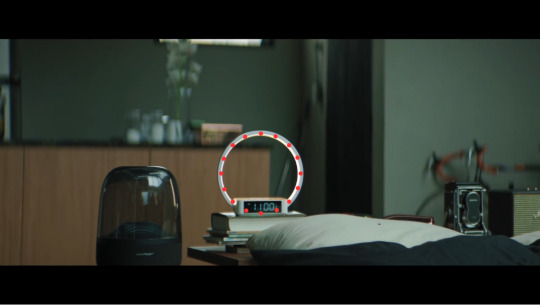
See how in the first frame the background is all blurred out, but once Great walks out of the frame - again, great that he walks out, movement!! Y’all don’t understand how boring 1000 Stars was for me to watch because of the lack of this stuff okay? - and then the focus shifts to the clock. Which is round.
God I know that sounds so dumb, but imagine the clock without that ring light bit on it, it’s just a tiny little rectangle. Not as fun or interesting to look at right? Or as noticeable especially from a distance?
This shift in focus also tells us “this is important” whatever “this” is. The subject of the shot goes from Great to the alarm clock but they are positioned as equally important. We’re meant to pay attention to this seemingly innocuous item, which we learn later in the episode is time. We’re meant to remember and note that time will be important to the story - I know with a title like 4 Minutes you’d fucking hope time would be important but have y’all ever read Youtube comments? It’s rough out there for visual comprehension okay?
So all in all this scene is only 1 minute and 40 seconds give or take. It’s very short, but I don’t think it was boring at all. I think it’s a really solid introduction to a main character. Think, Korn didn’t get this much time to showcase his introduction, his scene is shorter - though also well done - which showcases which character is more of a story priority.
This scene eases the audience into the story, inviting us to wake up into the world like Great is. It uses techniques like lines, shapes, symmetry, color and focus to make what could be a very boring scene into an interesting one.
There’s so so much I probably and certainly missed, I’m far from an expert, but I hope I was able to articulate what I liked about this scene, and why I think it looks good.
Stay tuned for more if I can manage to focus long enough to breakdown more scenes lol
Also red dots on Bible’s nipples are just funny to me it be what it be.
Further Reading:
Composition in Cinematography / THE LAST OF US
Center-Framing vs Chaos-Cinema: Mad Max vs Transformers
Camera Framing: Shot Composition & Cinematography Techniques Explained [The Shot List, Ep 2]
The Ultimate Guide to Camera Shots (50+ Types of Shots and Angles in Film)
Color Grading 101 - Everything You Need to Know
Mixing Film And Digital Footage: Killers Of The Flower Moon
In Praise of Subtle Cinematography
#4 minutes#4 minutes the series#bible sumettikul#4minutes#jesbib#chaos pikachu speaks#pikachu's bl film series
273 notes
·
View notes
Text
Our Youth Final Thoughts
Important edit added March, 5, 2025: It was reported (or at least I found out about it today) that the actor who portrayed Haruki in this show, was accused and arrested by Hong Kong police for SAing a translator after a fan event. It should go without saying, but I'll say it anyway, that is absolutely reprehensible behavior, and I hope his victim is able to get justice. If this knowledge affects your desire to watch this show, that's understandable and very fair. Shows like this are the unified works of dozens of creatives, and they do deserve to have their work appreciated, and things like this happening create even more barriers to queer stories being able to be told. I put this in simply because I don't want anyone walking into this story, identifying with this character, and the. Finding out later and being disheartened and disappointed, as I was.
I don't actually think I've posted much about Our Youth on here, but I finished the series over the weekend and wanted to talk about my overall thoughts.
There's so much I loved about the show. It's the first show in quite a while that I actively felt excited to watch every week. It's a trope that I'm often a fan of the 'bad boy with a heart of gold' and the 'nerd'. I did describe the show to a friend as 'what if Bender and Brian from the Breakfast Club ended up together?' which isn't the most inaccurate tagline, but is certainly not the most contemporary.
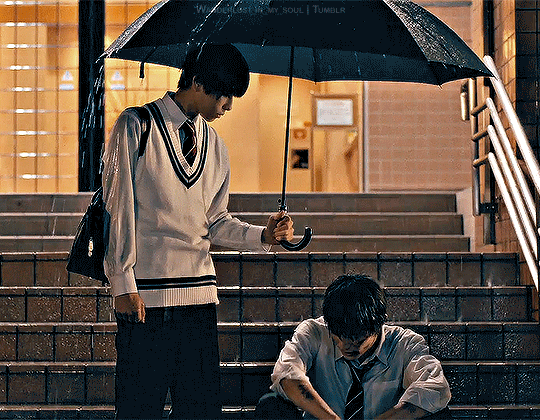
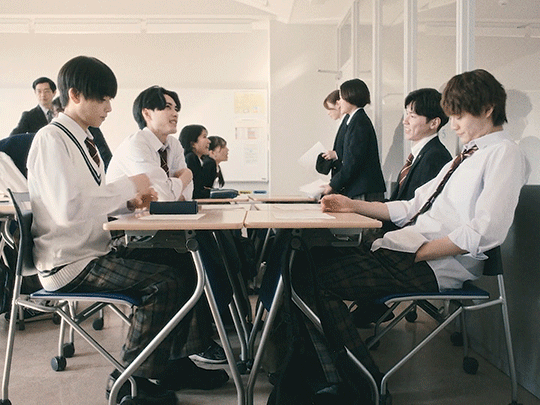
There's so much to talk about. I'll start by saying that one of the things that I really appreciated, that spoke to me about the series is how integral queer media is to the story of the characters. Haruki seeing and finding comfort in a queer film, this film being one of the sources of strength he has as he survives the abuse of his father, and eventually opens a door for him to become a filmmaker and tell his own stories is beautiful. It so clearly showcases how queer media is life-changing and life-saving for many queer youth.
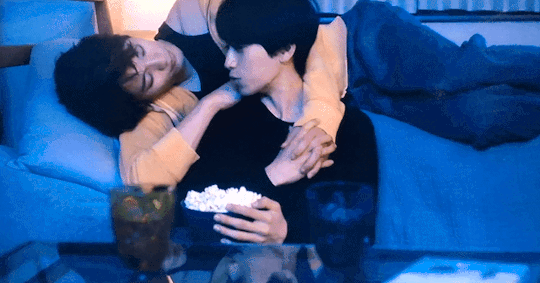
There's also this element of telling your own story. We see that directly with Haruki's films, but it's also present in Jin's writing. I think one of the most heartbreaking things we see there is that Jin's story is never 'public', we don't see Jin take a chance there. But there is value in him finding the courage to give Haruki a chance to read his work. Sometimes there's victory in trusting just one or a few people, it doesn't have to be all or nothing.
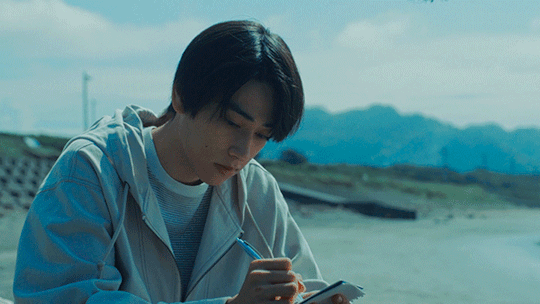
Another theme or topic brought up in the series, particularly in the finale, is marriage equality. I've been taking in a lot more Japanese BLs this last year than I really have Thai BLs or Korean BLs, Taiwanese, etc., and I've seen this brought up more than previously. It's not always as direct as here, but it's there. Seeing over the last 2-3 years marriage equality brought to the forefront in Thai BLs, and now in a matter of days we'll see the new marriage equality law go into effect there, that it kind of gives me hope. I know the societal pressures are different there, and in a lot of ways it's a don't ask, don't tell situation, but consistently bring up the topic, normalizing queer love, both in queer media and in mainstream media, helps to create a path for that progress.
tumblr
Another aspect I think is well done, though not perfect, is how the time jumps are handled with-in the story. By my figuring the story spans a bit more than a decade, and when creating, and specifically casting that, it can be hard not to create something where you feel like it's teens playing dress up as their father's by the end, or adults acting unconvincingly as children in the beginning, but there's a good balance here, at least with Jin and Haruki. I think part of the stems from the actors ages, Jin's being only 20, and Haruki's 25. that age difference allows Jin to look HS age, and him being believable as young lends credibility to Haruki. It's also almost a visual shorthand for Haruki to look older while they're in HS because he basically had to 'grow up' quickly, leave his childhood behind because of the abuse of his father. Once they move into the university years, they're basically the age of university students, no suspension of disbelief needed, and then in the final episode with that flash forward, it's not unbelievable to think they'd look somewhat the same. Contentment and happiness will hold off a lot on the aging process.
So to move beyond these kind of larger, more impactful concepts, lets get in close and talk some about Haruki and Jin as characters and a couple. The story kind of sets them up to be opposites, but they're more of a mirror of each other than anything. Both suffer from the neglect of their parents, distanced both physically and emotionally, and it's pretty draining for both of them. I think it sets them up to almost recognize each other in a way. Once they both take those small steps to open up to each other, we see the way they treat each other with so much care. There's moments where both are a bit rough around the edges, especially in the first handful of episodes, where they kind of let their emotions overwhelm them, but in most of their interactions, even starting in that first episode, they're so gentle with each other. I really started to pay attention to body language and how characters interact with each other after my no subs watches of Taikan Yoho, and it was to a level here that it was really noticeable or noteworthy.

That gentleness from both of them, that willingness to reach out, even when they're still so young and unsure, shows so much care. These are two boys (in the beginning) that don't feel loved, much less truly valued. The way the treat each other shows that they value the other. They value their thoughts, their feelings, and even the others' future, to the detriment of their own emotional wellbeing. That's a really hefty gift to give someone, and I think they only really feel comfortable doing so because it's reciprocated, even from the very start.
Taking them separately, we'll start with Jin. Jin is easy, he makes himself easy, he doesn't cause a fuss or an uproar, he just exists quietly. Which when you look deeper, when you take the time to look, to see, you see this incredible loneliness in him. What makes it frustrating as a viewer, is we see him having active discussions with teachers, there's opportunities there for people to recognize what's going on there, but the unfortunate thing is that obedient children are kind of overlooked. And Jin often overlooks himself. He's not necessarily shown to have ambitions on the same level as Haruki, but it reads to me more than he's not really allowed himself to really think about his dreams. He's lived his whole life with this understanding of what the expectations are, and so why would he ever seriously considered something outside of that. It lends the finale it's own bittersweetness, because we see Jin choose Haruki, to decide to take that leap, and while he may not be doing it as boldly, but in his own sort of mild, unassuming way, it's still Jin putting his desires first, and that's a triumph on it's own.
To talk about Haruki, Haruki is heartbreaking. Specifically because the way the narrative is presented, we don't know the full story until we're half-way through and already half-way in love with him. We see him through Jin's eyes in the beginning, beautiful, mysterious, almost unfathomable, and as those first few episode pass we start to see a little bit more. The shift in episode 5, now seeing in the story from Haruki's perspective is a rude awakening in many ways. It wasn't that we didn't have empathy for him before, we certainly did, but seeing so blatantly what he was dealing with hits hard. And it wasn't just about the physical abuse he had been dealing with, which is horrific on it's own, but the way Haruki was so close to giving up. The scene I can't get out of my mind is him saying "Whenever he beat me, I decided I wanted to die." That lack of desire to fight to survive shows how much everything had been wearing on him for so long. When he starts to know Jin, when he starts seeing that a future is possible, we see that fight start building up in him, and it's a relief to see. I found myself after episode 7 feeling so frustrated with him because we we had basically watched him be used and abused by his father OR sacrificing for others. We see him having made the choice to not reveal what he's dealing with to his mother, he decides to take the fall and get suspended from school, with the assumption being that he feels that Jin will be better off without him. He doesn't want Jin to choose to stay instead of studying abroad, because he knows Jin has a bright future and he doesn't want to affect that. But for myself, with the perspective of age, I know that there's hope, that Haruki has a future. So I was very in my feels after all of that.
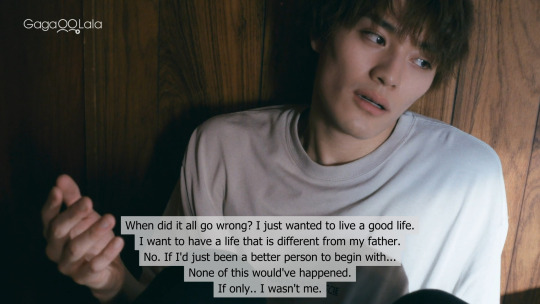
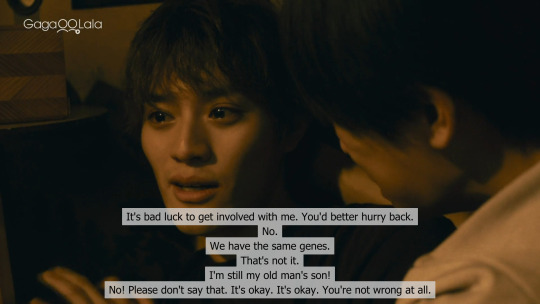
After our time jump into university seeing Haruki now actively pursuing his dream is a relief, with its own counterpoint of sadness as we are seeing Jin pursue a degree he has no passion for. It's all part of what makes this story so affecting, I think. Life is not all hope and rainbows, but it's also not all loneliness and pain. And there's a realism in choosing a future that's steady instead of taking a chance, the same way there's realism in pursuing a dream that seemed unreachable, knowing that there is a safety-net for you if things don't work out.
To talk a bit about what I didn't like- their parents. All of them sucked. Yes, arguably Haruki's dad was by far the worst, being a raging alcoholic who was physically abusive to his son for likely at least a couple years if not more. But even Haruki's mother doesn't get much sympathy from me, though we do see that Haruki holds no grudge for her (because of his fucking self-sacrificing bullshit). Jin's parents, I almost have no words for. There's an acute lack of interest from both, but we'll talk about dad first since I have less to say about him. It surprises me that Jin's dad is as emotionally distant as he is. We see that Jin has a great deal of respect for his dad, he appreciates and has an interest in his work, but his dad never thinks to build on that. I just find it odd. As far as Jin's mother, she's physically a bit more present, though I feel if you asked her flat out if she loved her son she might have to stop and think about it. He's basically a to-do list in her calendar, something that needs to be checked on and checked off, and I wonder how bad it was before the start of the shows timeline. It's not good that a teenaged Jin is being left for weeks at a time on his own, but when did they start doing that? It's a common trope for young Japanese children to be self-sufficient, and it's so open ended that my mind can't help but picture 8, 9, 10 year old Jin being left for days. But he's good, and obedient, and that's just life, so he goes on, and how heartbreaking is that?!? And I'll be honest, I was genuinely surprised to see her texting Jin in the final episode when we've flashed forward. When it feels like neither of them actively work to keep that bond intact, how was it still there? I suppose the answer is duty.
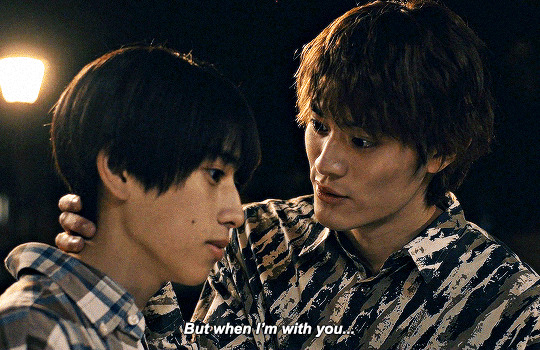
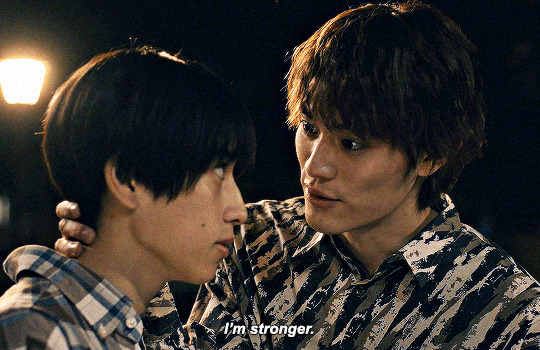
The emotional and physical trauma both Haruki and Jin deal with, I also didn't love--because it made me an absolute emotional wreck. I have some mixed feelings over how some things were handled, or specifically how most things were not at all handled. The resolution for a lot of the issues that we see is no resolution. Yes, we see that the emotional connection forged between Haruki and Jin is a beacon for both, enabling them to weather their individual storms, once that concept is established, it kind of drops off to nowhere. It's not even that it's built upon to the point where they both become self-sufficient or confident in themselves, it just is there, then in ep 7 (I think) they just go their separate ways and we're never shown that they're still affecting each others lives. We're shown that they're still in love with each other, that the other is still in their thoughts, but not how their experiences helped to shape them directly. It's worse with Haruki's father's death. It's an INSANELY traumatizing event, and it's almost treated like "well now he can't beat him any more and he can go live with his mom and everything is fine", and like...WHAT? Setting aside for a short moment the fact that being the one present at the loss of a parent even an abusive one, is gonna be traumatic, there's so much emotional distress and grief that comes from losing an abusive parent, especially as a child. Because it's not just grief of the person, it's grief of the unknown. Could there have been a future where his dad got sober and they had a happy life? A time where his dad became what he had been before? A revisit of that loving father? So you're also working through that loss also, and that's really not even a blip of a thought it feels like.
My final thought is something I didn't like, because it made me sad, but also still makes sense within the narrative, and that's the fact that we never see Jin or Haruki come out. I know we get tired of coming out stories, and I didn't need a dedicated scene or episode showing either coming out, but in the final episode where we see the friend group come back together we're shown in no uncertain terms that they are not out to them, & even more that their friends don't know they're dating each other. And I think that sucks. I think it's reasonable and understandable that either might not be out to their parents (though fr your dad makes gay movies Jin--so why not?) or to coworkers and acquaintances, but to have friends you've seen and known for more than a decade and you're still afraid? That's so sad.
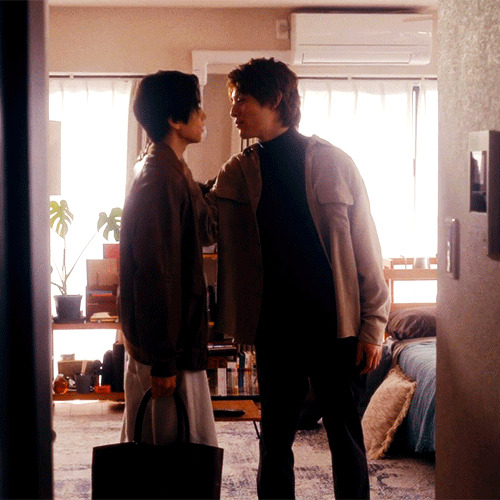
Overall, the word I might use to describe this love story is unassuming. It's not necessarily bold, but steady, which is something both characters need. They went through their teen years with different versions of upheaval and loneliness, and in the end they have each other, they have work that supports them, and they feel like they have a future, and that's something I think their teenage selves could have never even imagined.
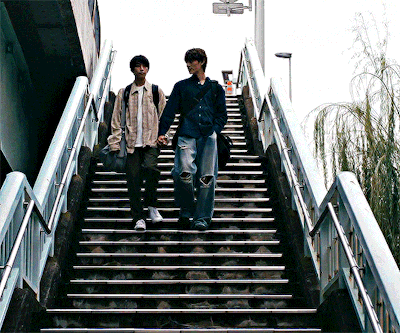
Thanks for reading.
*Also, I pulled some pics/stills whatever from @colourme-feral who has an excellent series offering more context to the subtitle translations. Absolutely amazing, and I definitely recommend checking them out if you haven't.
Link: https://www.tumblr.com/colourme-feral/search/miseinen%20translation/original
#Our Youth#Our Youth the series#Miseinen: Mijukuna Oretachi wa Bukiyou ni Shinkouchuu#Kamimura Kenshin#Motojima Junsei#Haruki x Jin#Jin x Haruki#HallieSMeta
28 notes
·
View notes
Text
For years following his highly publicized antisemitic outbursts, Mel Gibson couldn’t find much work in Hollywood.
But now he’s back in the filmmaking capital — as Donald Trump’s “special ambassador.”
The president-elect announced Thursday he was appointing the actor-director, along with fellow conservative celebrities Jon Voight and Sylvester Stallone, to the newly created role of “Special Ambassadors to a great but very troubled place, Hollywood, California.”
In his Truth Social post Trump provided few details of what such a role would entail, but hinted that Gibson and the others would push his ideas on the entertainment industry, and that he would lean on them for advice on the subject.
“They will serve as Special Envoys to me for the purpose of bringing Hollywood, which has lost much business over the last four years to Foreign Countries, BACK—BIGGER, BETTER, AND STRONGER THAN EVER BEFORE!” Trump wrote days ahead of his inauguration. “These three very talented people will be my eyes and ears, and I will get done what they suggest. It will again be, like The United States of America itself, The Golden Age of Hollywood!”
Hollywood’s Golden Age featured prominent Jewish talent and studio executives. Gibson, meanwhile, has become better known in recent years for his antisemitism.
In 2006, arrested on suspicion of drunk driving, the “Braveheart” star shouted, “F—ing Jews,” adding, “The Jews are responsible for all the wars in the world,” and asking his arresting officer if she was Jewish.
The incident came only two years after the initial release of “The Passion of the Christ,” a controversial biopic of Jesus that Jewish groups said dramatized antisemitic canards about Jews being responsible for Jesus’ death.
Gibson — whose father Hutton was a prominent Holocaust denier — later apologized for his drinking, and also issued an apology to “everyone in the Jewish community” through the Anti-Defamation League. “There is no excuse, nor should there be any tolerance, for anyone who thinks or expresses any kind of Anti-Semitic remark,” Gibson wrote in his statement at the time, adding a plea to members of the Jewish community to “help me on my journey through recovery.” Still, his reputation among the Jewish community took a nosedive, as did his career for a brief time.
His reputation took another hit a few years later when he made graphic and racist threats of domestic violence to his then-spouse. The actress Winona Ryder, who is Jewish, has also accused him of calling her an “oven dodger,” an allusion to the Holocaust.
But despite the setbacks, Gibson was never out of the game completely, and in recent years has reentered Hollywood with success. In 2016 his World War II drama “Hacksaw Ridge,” starring Jewish actor Andrew Garfield as a Christian conscientious objector, was nominated for six Oscars including best picture and best director for Gibson. He has said he plans to film a follow-up to “The Passion” next year.
Trump has sworn to curtail antisemitism during his second term in office. Himself a longtime fixture of show business, the president-elect has long exhibited a love-hate relationship with Hollywood. While he gained resurgent fame with his reality show “The Apprentice” in the 2000s, he frequently used his first term’s bully pulpit to attack celebrities who criticized him. And he had harsh words for the film industry after the 2019 South Korean thriller “Parasite” won best picture at the Oscars, the first non-English-language film to do so.
“And the winner is a movie from South Korea. What the hell was that all about?” he said at a rally shortly after the ceremony. “Can we get ‘Gone With the Wind’ back, please? ‘Sunset Boulevard’?”
In 2017, Gibson reportedly made donations to a Holocaust survivor organization. Last year he endorsed Trump in the presidential election, and last week his Malibu home burned down in the ongoing Los Angeles fires.
31 notes
·
View notes
Text
replying to this post bc it was filled with so much stupid stuff that i just. have to debunk it! links to the articles below!




TL;DR: these links are mostly just sensationalized media, top 10 lists, or opinion pieces, and antis are dumb <3 sorry for the LONGGGG post, i just couldn't help myself
I would like to preface, though, that just because these people were deeply mentally disturbed, does not mean that every mentally ill/schizophrenic/psychopath/sociopath/whatever is a murderer, or even a bad person. In a lot of these cases, the system/their parents/their friends failed these people, and it sucks.
Teen Kills Brother, Loves TV Show 'Dexter': Life Imitating Art?
For context, Anthony Conley, 17, killed his 10 yr old brother Conner. He was sentenced to life in prison, without parole.
If you look into the case itself (or even just READ THE ARTICLE ABOVE), Conley had said to the police that he'd been fantasizing about killing people since eighth grade, and that he heard voices. Three experts examined him and said he was *severely* mentally ill, and a fourth who didn't interview him believe he showed signs of being a psychopath. This is a clear-cut case of someone who was not mentally stable having access to material that furthered those thoughts, but Dexter did not cause his actions.
"The Dexter Killer:" Inside the mind of a murderer
Context - Mark Twitchell, an aspiring filmmaker, catfished a man, directing him to his garage that he had decked out with plastic coverings a la Dexter, and killed him. He later attempted to do this to another man, but that one escaped. He was sentenced to life in prison, with possibility of parole after 25 years.
Twitchell himself would describe himself as a psychopath. He cheated on his wife, would cheat people for money, was a pathological liar, and said he had a lack of empathy. He'd also written a screenplay for a film he intended to make, in the hopes it would "prevent him from killing". He also said himself that Dexter did not CAUSE the killing, but I can't deny he might've gotten some ideas from the show (the catfishing, the plastic tarps). Still not the fault of Dexter, though, as Twitchell clearly had some issues prior to watching the show.
Korean true crime fan murdered stranger 'out of curiosity'
Context - Jung Yoo-jung, obsessed with true crime, used an app to meet an English-language teacher, and stabbed her to death. She was sentenced to life.
Jung, like the other two, was mentally ill. She was also a loner, a recluse, was unemployed, and lived with her grandpa. She scored high on psychopathy tests, claimed she had hallucinations, and claimed that she had a host of other mental health issues. She'd been researching true crime for months, and spent more months seeking out a victim, contacting over 50 people -mostly women- and decided to kill because of her "morbid curiosity". There's also the alleged "feeling of resentment and anger toward her family", and the fact that the woman she killed was stabbed 100+ times indicates it was more personal for her. "It seems that the background of the accused may have influenced the formation of an abnormal personality," the court said.
Fiction is Reality, As Far As Your Brain is Concerned (You have to make an account to view this one.)
This is nothing. This is an opinion piece from someone who is just a journalist. Honestly, I could make a whole post talking about how biased and just. plain wrong it is. I might.
It starts with the conclusion that the way we differentiate reality from fiction is based on how well it connect with our existing experience, which is true to a degree, but the study they cite does not use that fact in the same way the article does.
The study very clearly defines that (as young as) 5 year olds have no problem differentiating fiction from reality, just that Santa, or the tooth fairy, for example, are more "real" than dragons and the like because they have more experience from seeing them (mall Santas, or money under their pillow), than they do a dragon, which has only been seen on TV or books.
The article, however, takes this to mean that the brain has the ability to rewire itself, or misremember, to convince itself that Santa actually exists. It uses the example that "Frodo is more real than Kim Jong-Un" because we may have more "personal connection" to Frodo, than we do Kim Jong-Un, due to us having seen the movies, or reading the books, and making a connection to the character, but that is totally contradicted in the study above ("Our conceptual knowledge in relation to real people is far more extensive and multifaceted compared to that of fictional entities. For instance, the kind of associations most people have for a fictional character such as Cinderella (evil stepfamily, glass slipper, fairy godmother, the handsome prince, midnight, etc.) are limited to the context of the story in which we learnt about her. In comparison, our associations about a real famous entity such as George Bush is far more wide-ranging (his appearance, his position in the social hierarchy, my personal feelings towards him, my knowledge regarding the feelings of others towards him, his politics, his team, his family, the degree of influence he has on my life, the last time I saw him on TV, etc.).")
This is just a taste of how wrong the article gets it, because the entire thing is hinged upon their incorrect reading of the study that was done. In conclusion, bad article.
Movies That Inspired Real-Life Crimes That Shook The World
This is a list, so I'm gonna go over this quickly.
Leonard Lake was not inspired by The Collector. As a child, long before he read the book, he developed a fascination with pornography, photographed his sister nude (which his grandmother encouraged), allegedly killed mice and dissolved them in chemicals, and was later discharged from the Marines due to mental issues.
I can't find the specific cases this one's linked to (1971-1973, so it's old), but I will say that copycat crimes are usually done by people with prior records or severe mental problems.
Patricia Frazier had previous mental health issues, had been institutionalized four years prior to the murder, was later found incompetent to stand trial, diagnosed with paranoid schizophrenia, and was found not guilty by reason of insanity. Again, mental health is the problem here, not The Exorcist.
Mark Branch had been under psychiatric care for several years, with one report saying he'd sought treatment at a psychiatric hospital. He also killed himself after the murder. Did Friday the 13th give him some ideas? Yeah, probably. Was that the movie's fault, and should he have been watching it? No.
Richard Boyer was under the influence of PCP, weed, and alcohol while watching the movie, and on the day of the murder, he ingested PCP, cocaine, and alcohol. I feel it pretty safe to say Halloween II was not the only cause of the murders, and the jury agrees with me. Jake Evans had been planning on killing his mom and sister for a while, saying "I guess this is really selfish to say but, to me, I felt like they were just suffocating me in a way." He said himself that he didn't want anyone thinking Halloween influenced him, either. So I highly doubt it was the movie that caused it.
Daniel Gonzalez was known as a "dark and troubled boy" in school. He had psychological problems, and from the age of 17 he'd received both inpatient and outpatient care, suffered with schizophrenia, and used drugs. He just liked the movie Nightmare on Elm Street, and wore a hockey mask like Jason Vorhees, but that's the only connection there was to those movies. Ultimately, the problem lies on the NHS for not helping him.
Martin Bryant had mental health issues. He killed and tortured animals as a child, would shoot birds for fun, and later set himself on fire. He was assessed and found to be possibly Schizophrenic, with a fascination with fire. He also had a low IQ, and was at a lower intellectual functioning capacity than his peers. He was known to be violent in school, was a nuisance to people around him, firing air rifles at tourists and spitting at visitors. No connection to Child's Play other than he liked quoting the movie sometimes. There's no proof to suggest Jon Venables and Robert Thompson had even watched Child's Play, that is just a theory, and a poor one at that.
Nathaniel White was previously in jail for robbery, then after murdering a 29 year old woman, he was arrested again for abducting a 16 year old girl at knifepoint, and was accused of child abuse by social services about a month before the last 5 slayings. He also enjoyed the attention he got from the press, so chances are he wanted something to make him "stand out", and make a name for himself, so he became "the RoboCop 2 killer".
Sarah Edmondson and Benjamin Darras were not only copycat killers, and known by the cops, AND did drugs, but they were on LSD and watched the movie repeatedly before their murder spree to hype themselves up. They did it for the attention, not because Natural Born Killers told them to. Don't even get me started on Columbine and how NBK had really nothing to do with what was wrong with those boys.
Brian Draper and Torey Adamcik may have said they were inspired by Scream, but it's much more likely they were inspired by Columbine, considering they said they wanted to "outdo" Eric and Dylan, as well as referencing them in their tapes. Again, they wanted fame (and pleasure, with Adamcik saying he was "horny just thinking about it"), which is why they recorded it. They wanted the attention. Not much to do with Scream at all.
With The Matrix, it seems to just be a bunch of people who have a very loose grip on reality to begin with, and that movie just made them lose it further. It was not the cause.
Same thing, different guy. Matthew Tinling was a drug user, and clearly not in his right mind, because he later attacked 2 other people while in prison.
This one's just stupid. Fight clubs didn't come from the movie, it's a gambling thing. Literally not even connected to the movie.
Kim de Gelder said he had nothing to do with the Joker, had depressions as a teenager, and claimed to hear voices in his head. Police investigators and De Gelder's lawyer both have said The Dark Knight was not a motive to his attacks.
The first thing referenced was just a hoax, and a bunch of people getting scared about it, and the second one, Johnathan Cruz, has a record. Robbery, attempted robbery, criminal confinement, kidnapping, intimidation, battery, assault, just to name a few, and was allegedly associated with a gang. The Purge has very little to do with the actual crimes.
Real Life crimes inspired by films and TV shows...
Here we go again...
This is the only one I can find with no criminal or psychiatric history to explain his behaviour. But if I would have to guess.. Copycat killer, attention seeker. Still not the movie's fault it happened, because plenty of other people have watched Scream and haven't killed people!
Not much I can find about this except for his sentence, but again, he might've gotten some ideas from Fight Club, but normal people don't commit arson and bomb buildings just because they watch a movie.
Not much to say about this other than two kids made a prank call and it went bad. Not much to do with Saw, other than them mentioning toxic gas.
Can't find anything about this one, but maybe teach your kid that biting other kids is bad? I don't see how that's the fault of Twilight.
14 year old with unsupervised access to the internet becomes obsessed with serial killers, and has access to weapons. Definitely American Psycho's fault, and not his parents'.
James Holmes' murders had nothing to do with The Dark Knight, other than the fact that he committed his acts during that movie in a theater, and that he maybe sorta liked Batman, but the attorney who prosecuted him said there was no evidence to suggest he was obsessed with Batman, and the psychiatrist that interviewed Holmes said he just picked that movie because it was guaranteed to be full.
Top 10 Real-Life Crimes Inspired By Movies And TV
This one's more of the same.
The Hi-Fi murders were gonna be done either way, they were just looking for a way to do it quietly and cleanly, and they just so happened to settle on the Drano thing from Magnum Force. It was always going to happen, regardless of method. John Hinckley Jr. was obsessed with Jodie Foster, not Taxi Driver, was found not guilty by reason of insanity, and was institutionalized for over three decades. He was not right in the head to begin with.
Japanese man charged with sexual assault used 'radiation inspector' ploy
Can't find much about this, but again, I'd bet a year's wages he'd have still molested those girls, even without that plot from a manga he read. That was just the vehicle he used to commit the crime, but the crime was gonna happen regardless.
Also. It says he carried out as many as 20 similar attacks in the three years before his arrest. If I'm reading this correctly, the radioactivity thing was new, something he'd only recently seen in a manga and used to hurt these girls, and the other 20 attacks were not associated with that manga. If that's the case, then I'm right.
How a birth mark on his leg helped catch this terrifying serial sex attacker
He'd been thinking about this stuff from a very young age, with his awakening being seeing Princess Leia in chains. That is the only connection to fiction with this guy. He's a rapist, why are we trying to give him excuses?
IN CONCLUSION. That anti's post was bad. Like, really bad. Filled with major news sites that like to sensationalize everything, top 10 lists that don't actually do any sort of research into what they're talking about, and an article by someone who can't read a study past the abstract, and my only assumption is that that anti can't read, either.
#and considering that one person apparently trolls thru the proship tag. they're probably going to see this too!#this was hell. i don't get paid enough (or at all) to do this. but that post was so dumb i had to.#proship#profic#proshippers please interact#anti anti#pro ship#pro fic#🏁🎸
26 notes
·
View notes
Text
« Known globally for highly stylized genre films depicting the gritty underbelly of society with brutal violence and crimes, South Korean cinema was long characterized by what one film critic famously called “dark blue filter thrillers” mostly made by and starring men. If women appeared at all, it was often as one-dimensional clichés, serving as plot devices like a femme fatale, a murder or rape victim, an innocent lover or wife, or a self-sacrificing mother.
To challenge this norm and support women filmmakers, some women started to not only watch female-driven films but also buy more tickets than they could even use for such movies in a campaign called “spirit-sending”— meaning they would be at the theaters in spirit. The campaign turned a surefire box-office disaster to an award-winning hit, saving the career of a rare female director.
“It was truly a miracle,” Lee Ji-Won said of Miss Baek, her 2018 debut film about a female former convict trying to save a little girl from abusive parents. The drama, which portrays the friendship between two abuse survivors, was such a rarity in an industry dominated by what Lee called “films with cops, gangsters, naked women, or rom-coms” that it was snubbed by almost all investors and distributors. One investor promised to fund it only if Lee changed the lead character to a man. Another bet that “the disaster-in-waiting” would perish in cinemas in a week—a warning that almost materialized, as the film’s opening-day sales were so poor that it was projected to sell less than a quarter of the tickets required just to break even.
“Everybody, myself included, was so sure that the movie would crash and burn, and my career was over—until weird things started to happen on social media,” Lee told me.
Impressed by the rare women-led film with complex female characters, made by an even rarer woman director, many women watched it again and again, buying tickets even when they couldn’t attend. Ticket sales rebounded sharply as #SendingSpirit became a viral hashtag that continued for months until the film broke even. Miss Baek eventually won rave reviews and swept major awards, and the same investors who’d once snubbed Lee began to court her, begging to see her scripts.
“The gesture of solidarity by all these women was just overwhelming,” Lee said, wiping away tears. “They, like me, were so thirsty for movies portraying women as complex, multidimensional human beings.” In 2021, she finished shooting her second movie, featuring some of the country’s biggest stars.
The “spirit-sending” campaign lived on to drive the success of other women-led movies, like the film adaptation of Kim Ji-Young, Born 1982, allowing such films to defy the boycott campaigns that often targeted “feminism-stained movies.” While the film was hit by thousands of 0 percent ratings even before its official release (causing a vast gender disparity in its ratings on the top web portal—2.99 among men and 9.45 among women), Kim Ji-Young eventually became a hit watched by millions at home. Female-driven movies have grown in numbers and ticket sales since, led by a new generation of filmmakers like Lee and some male filmmakers as well. »
— Hawon Jung, Flowers of Fire: The Inside Story of South Korea's Feminist Movement
116 notes
·
View notes
Text
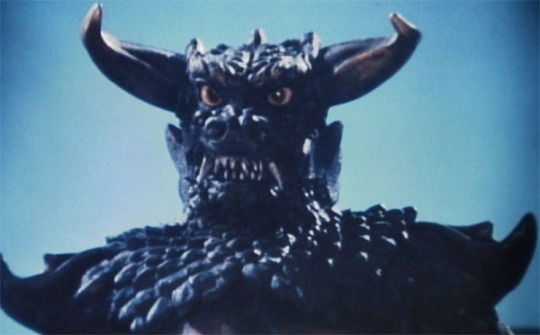
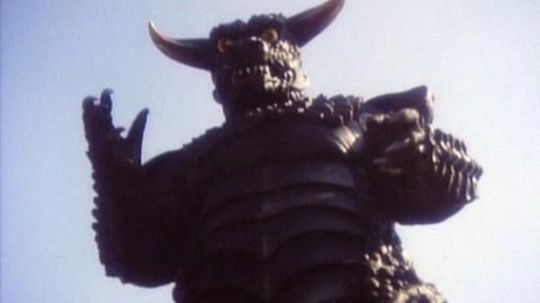

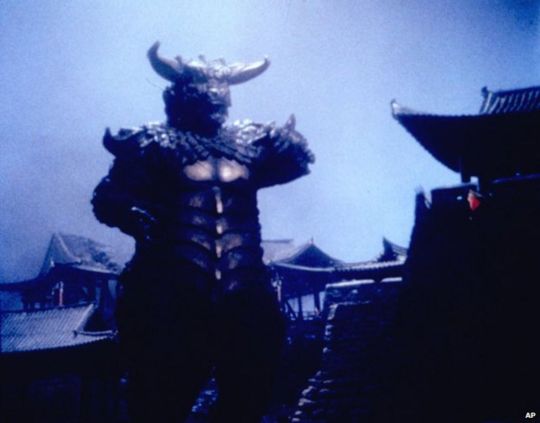
PULGASARI (1985)
The North Korean kaiju film produced by Kim Jong Il (before he became dictator of North Korea, and father of current dictator Kim Jong Un), directed by a kidnapped South Korean filmmaker, and featuring Godzilla suit actor Kenpachiro Satsuma as the monstrous Pulgasari.
Additionally, some Toho special effects technicians, most notably Teruyoshi Nakano, were duped into making the film. They were led to believe they were going to China for a project.
Pulgasari is a remake of sorts of Bulgasari (1962), South Korea's first kaiju film which is now considered lost. Both films were based on the same Korean myth about a giant iron-eating monster.
61 notes
·
View notes